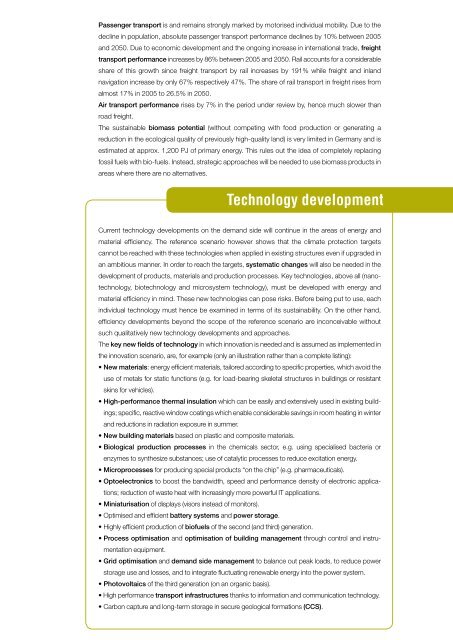Blueprint Germany - Öko-Institut eV
Blueprint Germany - Öko-Institut eV
Blueprint Germany - Öko-Institut eV
You also want an ePaper? Increase the reach of your titles
YUMPU automatically turns print PDFs into web optimized ePapers that Google loves.
Passenger transport is and remains strongly marked by motorised individual mobility. Due to the<br />
decline in population, absolute passenger transport performance declines by 10% between 2005<br />
and 2050. Due to economic development and the ongoing increase in international trade, freight<br />
transport performance increases by 86% between 2005 and 2050. Rail accounts for a considerable<br />
share of this growth since freight transport by rail increases by 191% while freight and inland<br />
navigation increase by only 67% respectively 47%. The share of rail transport in freight rises from<br />
almost 17% in 2005 to 26.5% in 2050.<br />
Air transport performance rises by 7% in the period under review by, hence much slower than<br />
road freight.<br />
The sustainable biomass potential (without competing with food production or generating a<br />
reduction in the ecological quality of previously high-quality land) is very limited in <strong>Germany</strong> and is<br />
estimated at approx. 1,200 PJ of primary energy. This rules out the idea of completely replacing<br />
fossil fuels with bio-fuels. Instead, strategic approaches will be needed to use biomass products in<br />
areas where there are no alternatives.<br />
Technology development<br />
Current technology developments on the demand side will continue in the areas of energy and<br />
material efficiency. The reference scenario however shows that the climate protection targets<br />
cannot be reached with these technologies when applied in existing structures even if upgraded in<br />
an ambitious manner. In order to reach the targets, systematic changes will also be needed in the<br />
development of products, materials and production processes. Key technologies, above all (nanotechnology,<br />
biotechnology and microsystem technology), must be developed with energy and<br />
material efficiency in mind. These new technologies can pose risks. Before being put to use, each<br />
individual technology must hence be examined in terms of its sustainability. On the other hand,<br />
efficiency developments beyond the scope of the reference scenario are inconceivable without<br />
such qualitatively new technology developments and approaches.<br />
The key new fields of technology in which innovation is needed and is assumed as implemented in<br />
the innovation scenario, are, for example (only an illustration rather than a complete listing):<br />
• New materials: energy efficient materials, tailored according to specific properties, which avoid the<br />
use of metals for static functions (e.g. for load-bearing skeletal structures in buildings or resistant<br />
skins for vehicles).<br />
• High-performance thermal insulation which can be easily and extensively used in existing buildings;<br />
specific, reactive window coatings which enable considerable savings in room heating in winter<br />
and reductions in radiation exposure in summer.<br />
• New building materials based on plastic and composite materials.<br />
• Biological production processes in the chemicals sector, e.g. using specialised bacteria or<br />
enzymes to synthesize substances; use of catalytic processes to reduce excitation energy.<br />
• Microprocesses for producing special products “on the chip” (e.g. pharmaceuticals).<br />
• Optoelectronics to boost the bandwidth, speed and performance density of electronic applications;<br />
reduction of waste heat with increasingly more powerful IT applications.<br />
• Miniaturisation of displays (visors instead of monitors).<br />
• Optimised and efficient battery systems and power storage.<br />
• Highly efficient production of biofuels of the second (and third) generation.<br />
• Process optimisation and optimisation of building management through control and instru-<br />
mentation equipment.<br />
• Grid optimisation and demand side management to balance out peak loads, to reduce power<br />
storage use and losses, and to integrate fluctuating renewable energy into the power system.<br />
• Photovoltaics of the third generation (on an organic basis).<br />
• High performance transport infrastructures thanks to information and communication technology.<br />
• Carbon capture and long-term storage in secure geological formations (CCS).

















